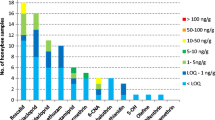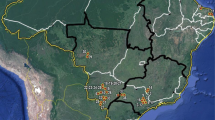Abstract
Pesticide residues in honey can negatively affect bee health. Although recent studies have detected neonicotinoid residues in honeys from around the world, little is known about how residues relate to land use and vegetation composition. To investigate potential relationships, we sampled multi-floral honey from 30 Apis mellifera hives from urban, agricultural and semi-natural habitats (SNH), identified and quantified three neonicotinoids present (clothianidin, imidacloprid and thiacloprid) using UHPLC-MS, and classified surrounding land use up to 5 km around hive sites. Neonicotinoids were most frequently detected in honeys from hives in agricultural habitats, and 70% of all samples contained at least one of the three neonicotinoid compounds. Imidacloprid was the most frequently detected neonicotinoid (found in 43% of honey samples) followed by clothianidin (40%) and thiacloprid (37%). Almost half (48%) of samples contained at least two neonicotinoids, and two of the 30 samples contained all three. Clothianidin and thiacloprid were more frequently detected in honeys from urban habitats, highlighting that exposure to pesticides does not just occur in agricultural settings. This suggests that pesticide use in urban domestic, sport and amenity contexts, given potential exposure of bees and other pollinators, needs urgent consideration.





Similar content being viewed by others
Data availability
The datasets used and/or analysed during the current study are available from the corresponding author on reasonable request.
References
Al-Waili N et al (2012) Antibiotic, pesticide, and microbial contaminants of honey: human health hazards. Sci World J 2012:930849
Bargańska Ż, Ślebioda M, Namieśnik J (2013) Pesticide residues levels in honey from apiaries located of Northern Poland. Food Control 31:196–201
Basley K, Goulson D (2018) Neonicotinoids thiamethoxam and clothianidin adversely affect the colonisation of invertebrate populations in aquatic microcosms. Environ Sci Pollut Res 25:9593–9599
Beekman M, Ratnieks FLW (2000) Long-range foraging by the honey-bee, Apis mellifera L. Funct Ecol 14:490–496
Berg CJ et al (2018) Glyphosate residue concentrations in honey attributed through geospatial analysis to proximity of large-scale agriculture and transfer off-site by bees. PLoS One 13:e0198876
Botías C, David A, Horwood J, Abdul-Sada A, Nicholls E, Hill E, Goulson D (2015) Neonicotinoid residues in wildflowers, a potential route of chronic exposure for bees. Environ Sci Technol 49:12731–12740
Brandt A, Gorenflo A, Siede R, Meixner M, Büchler R (2016) The neonicotinoids thiacloprid, imidacloprid, and clothianidin affect the immunocompetence of honey bees (Apis mellifera L.). J Insect Physiol 86:40–47
Campillo N, Viñas P, Férez-Melgarejo G, Hernández-Córdoba M (2013) Liquid chromatography with diode array detection and tandem mass spectrometry for the determination of neonicotinoid insecticides in honey samples using dispersive liquid-liquid microextraction. J Agric Food Chem 61:4799–4805
Casado J, Brigden K, Santillo D, Johnston P (2019) Screening of pesticides and veterinary drugs in small streams in the European Union by liquid chromatography high resolution mass spectrometry. Sci Total Environ 670:1204–1225
Central Statistics Office, (2017). Trade Statistics February 2018, Available at: https://www.cso.ie/en/media/csoie/releasespublications/documents/externaltrade/2017/trade_feb2017.pdf. Accessed 1 Sep 2018.
Central Statistics Office, (2016). Environmental indicators Ireland - land use [Internet]. 2016. Available at: https://www.cso.ie/en/releasesandpublications/ep/peii/eii2016/lu/ [Accessed December 21, 2020].
Copernicus, (2018). CLC 2018. Available at: https://land.copernicus.eu/pan-european/corine-land-cover/clc2018 [Accessed April 26, 2020].
Copernicus, (2020). Corine land cover nomenclature guidelines. Available at: https://land.copernicus.eu/user-corner/technical-library/corine-land-cover-nomenclature-guidelines/html/index-clc-111.html [Accessed December 21 2020].
David A, Botías C, Abdul-Sada A, Nicholls E, Rotheray EL, Hill EM et al (2016) Widespread contamination of wildflower and bee-collected pollen with complex mixtures of neonicotinoids and fungicides commonly applied to crops. Environ Int 88:169–78
Department of Agriculture Food and the Marine, (2014). Pesticide usage in Ireland soft fruit crops survey report, Available at: http://www.pcs.agriculture.gov.ie/media/pesticides/content/sud/pesticidestatistics/PesticideUsage2014SoftFruitCropsSurveyReport100317.pdf. Accessed 1 Sep 2018.
Department of Agriculture Food and the Marine, (2011). Pesticide usage in Ireland vegetable crops survey report. Available at: http://www.pcs.agriculture.gov.ie/media/pesticides/content/sud/pesticidestatistics/PesticdeUsage-2011VegetableSurveyReport.pdf. Accessed 1 Sep 2018.
Department of Agriculture Food and the Marine in Ireland (2013). Plant protection products book 2013, Available at: http://www.pcs.agriculture.gov.ie/media/pesticides/content/products/book2013/Chapter01-ProductRegister.pdf. Accessed 1 Sep 2018.
Department of Agriculture Food and the Marine in Ireland (2018). Plant protection products book 2018. Available at: http://www.pcs.agriculture.gov.ie/media/pesticides/content/plantprotectionproducts/pppbook2018/PlantProtectionProducts2018FullBook230218.pdf. Accessed 1 Sep 2018.
EFSA (European Food Safety Authority) (2018) Conclusion on the peer review of the pesticide risk assessment for bees for the active substance clothianidin considering the uses as seed treatments and granules. EFSA J 16:5177
Environmental Protection Agency (2021) Common Data - CORINE Landcover 2012. Available at: https://gis.epa.ie/GetData/Download. Accessed 1 Jun 2015
Fernández-Bayo JD, Nogales R, Romero E (2009) Effect of vermicomposts from wastes of the wine and alcohol industries in the persistence and distribution of imidacloprid and diuron on agricultural soils. J Agric Food Chem 57:5435–5442
Gibbons D, Morrissey C, Mineau P (2015) A review of the direct and indirect effects of neonicotinoids and fipronil on vertebrate wildlife. Environ Sci Pollut Res 22:103–118
Goulson D (2013) An overview of the environmental risks posed by neonicotinoid insecticides. J Appl Ecol 50:977–987
Guilleminot SH et al (2019) A national wide survey of neonicotinoid insecticides in agricultural land with implications for agricultural -and with implications for agri-environment schemes. J Appl Ecol 56:1502–1514
Henry M, Beguin M, Requier F, Rollin O, Odoux JF, Aupinel P, Aptel J, Tchamitchian S, Decourtye A (2012) A common pesticide decreases foraging success and survival in honey bees. Science 336:348–350
Hladik ML, Corsi SR, Kolpin DW, Baldwin AK, Blackwell BR, Cavallin JE (2018) Year-round presence of neonicotinoid insecticides in tributaries to the Great Lakes, USA. Environ Pollut 235:1022–1029
Hou J, Xie W, Hong D, Zhang W, Li F, Qian Y, Han C (2019) Simultaneous determination of ten neonicotinoid insecticides and two metabolites in honey and Royal-jelly by solid−phase extraction and liquid chromatography−tandem mass spectrometry. Food Chem 270:204–213
Jeschke P et al (2010) Overview of the status and global strategy for neonicotinoids. J Agric Food Chem 59:2897–2908
Kavanagh S, Gunnoo J, Marques Passos T, Stout JC, White B (2019) Physicochemical properties and phenolic content of honey from different floral origins and from rural versus urban landscapes. Food Chem 272:66–75
Krupke CH et al (2012) Multiple routes of pesticide exposure for honey bees living near agricultural fields. PLoS One 7:e29268
Lambert O et al (2013) Widespread occurrence of chemical residues in beehive matrices from apiaries located in different landscapes of Western France. PLoS One 8:e67007
Lentola A, David A, Abdul-Sada A, Tapparo A, Goulson D, Hill EM (2017) Ornamental plants on sale to the public are a significant source of pesticide residues with implications for the health of pollinating. Environ Pollut 228:297–304
Lundin O et al (2015) Neonicotinoid insecticides and their impacts on bees: a systematic review of research approaches and identification of knowledge gaps. PLoS One 10:e0136928
Mitchell EAD, Mulhauser B, Mulot M, Mutabazi A, Glauser G, Aebi A (2017a) A worldwide survey of neonicotinoids in honey. Science 358:109–111
Mitchell EAD, Mulhauser B, Mulot M, Mutabazi A, Glauser G, Aebi A (2017b) Supplementary materials for a worldwide survey of neonicotinoids in honey. Science 358:109–111
Moffat C, Buckland ST, Samson AJ, McArthur R, Chamosa Pino V, Bollan KA, Huang JTJ, Connolly CN (2016) Neonicotinoids target distinct nicotinic acetylcholine receptors and neurons, leading to differential risks to bumblebees. Sci Rep 6:24764
Mullin CA et al (2010) High levels of miticides and agrochemicals in North American apiaries: implications for honey bee health. PLoS One 5:e9754
Nauen R, Ebbinghaus-Kintscher U, Elbert A, Jeschke P, Tietjen K (2001) Acetylcholine receptors as sites for developing neonicotinoid insecticides. In: Ishaaya I (ed) Biochemical sites of insecticide action and resistance. Springer, New York, pp 77–105
Paradis D, Bérail G, Bonmatin JM, Belzunces LP (2014) Sensitive analytical methods for 22 relevant insecticides of 3 chemical families in honey by GC-MS/MS and LC-MS/MS. Anal Bioanal Chem 406:621–633
Pisa LW, Amaral-Rogers V, Belzunces LP, Bonmatin JM, Downs CA, Goulson D, Kreutzweiser DP, Krupke C, Liess M, McField M, Morrissey CA, Noome DA, Settele J, Simon-Delso N, Stark JD, van der Sluijs JP, van Dyck H, Wiemers M (2015) Effects of neonicotinoids and fipronil on non-target invertebrates. Environ Sci Pollut Res 22:68–102
Raghunandan KS, Basavarajappa S (2013) Analysis of multifloral honey of the giant honeybee, Apis Dorsata F., for pesticide residues in Southern Karnataka, India. Eur J Zool Res 2:22–28
Rexrode, M. et al., 2003. EFED risk assessment for the seed treatment of clothianidin 600FS on corn and canola, Washington.
Rubio F, Guo E, Kamp L (2014) Environmental & analytical toxicology survey of glyphosate residues in honey, corn and soy products. J Environ Anal Toxicol 5:249
Silva V, Mol HGJ, Zomer P, Tienstra M, Ritsema CJ, Geissen V (2019) Pesticide residues in European agricultural soils – a hidden reality unfolded. Sci Total Environ 653:1532–1545
van der Sluijs JP, Simon-Delso N, Goulson D, Maxim L, Bonmatin JM, Belzunces LP (2013) Neonicotinoids, bee disorders and the sustainability of pollinator services. Curr Opin Environ Sustain 5:293–305
Sohn L, Brodie RJ, Couldwell G, Demmons E, Sturve J (2018) Exposure to a nicotinoid pesticide reduces defensive behaviors in a non-target organism, the rusty crayfish Orconectes rusticus. Ecotoxicology 27:900–907
Sullivan CA, Finn JA, Ó hÚallacháin D, Green S, Matin S, Meredith D, Clifford B, Moran J (2017) The development of a national typology for high nature value farmland in Ireland based on farm-scale characteristics. Land Use Policy 67:401–414
Tanner G, Czerwenka C (2011) LC-MS/MS analysis of neonicotinoid insecticides in honey: methodology and residue findings in Austrian honeys. J Agric Food Chem 59:12271–12277
The European Commission, (2018). Neonicotinoids. Available at: https://ec.europa.eu/food/plant/pesticides/approval_active_substances/approval_renewal/neonicotinoids_en [Accessed September 3, 2018].
Tosi S, Nieh JC (2017) A common neonicotinoid pesticide, thiamethoxam, alters honey bee activity, motor functions, and movement to light. Sci Rep 7:15132
Williamson SM, Willis SJ, Wright GA (2014) Exposure to neonicotinoids influences the motor function of adult worker honeybees. Ecotoxicology 23:1409–1418
Williamson SM, Wright GA (2013) Exposure to multiple cholinergic pesticides impairs olfactory learning and memory in honeybees. J Exp Biol 216:1799–1807
Wood TJ, Kaplan I, Zhang Y, Szendrei Z (2019) Honeybee dietary neonicotinoid exposure is associated with pollen collection from agricultural weeds. Proc R Soc B 286:20190989
Wood TJ, Goulson D (2017) The environmental risks of neonicotinoid pesticides: a review of the evidence post 2013. Environ Sci Pollut Res 24:17285–17325
Wyckhuys KAG, Aebi A, Bijleveld van Lexmond MFIJ, Bojaca CR, Bonmatin JM, Furlan L, Guerrero JA, Mai TV, Pham HV, Sanchez-Bayo F, Ikenaka Y (2020) Resolving the twin human and environmental health hazards of a plant-based diet. Environ Int 144:106081
Xie W, Han C, Qian Y, Ding H, Chen X, Xi J (2011) Determination of neonicotinoid pesticides residues in agricultural samples by solid-phase extraction combined with liquid chromatography–tandem mass spectrometry. J Chromatogr A 1218:4426–4433
Zimmermann J, Stout JC (2016) Underestimating neonicotinoid exposure: how extent and magnitude may be affected by land-use change. Sci Pollut Res 23:7050–7054
Zimmermann J, González A, Jones MB, O’Brien P, Stout JC, Green S (2016) Assessing land-use history for reporting on cropland dynamics - a comparison between the Land-Parcel Identification System and traditional inter-annual approaches. Land Use Policy 52:30–40
Zoller O, Rhyn P, Rupp H, Zarn JA, Geiser C (2018) Glyphosate residues in Swiss market foods: monitoring and risk evaluation. Food Addit Contaminants: Part B 11:83–91
Acknowledgements
The beekeepers of Ireland and Paula Meleady (NICB) are gratefully acknowledged.
Funding
Financial support was provided by the Irish Research Council, Ireland (Postgraduate Scholarship, S. Kavanagh) and DCU Career Start Fellowship (B. White).
Author information
Authors and Affiliations
Contributions
SK carried out all separations and sample analysis. SK also carried out the statistical analysis. MH contributed to experimental analysis and interpretation of the results. SK, BW, JCS and MH contributed to the text of the article. SK, BW, JCS and MH read and approved the final manuscript.
Corresponding author
Ethics declarations
Ethics approval and consent to participate
Not applicable.
Consent for publication
Not applicable.
Competing interests
The authors declare no competing interests.
Additional information
Responsible editor: Philippe Garrigues
Publisher’s note
Springer Nature remains neutral with regard to jurisdictional claims in published maps and institutional affiliations.
Supplementary Information
ESM 1
(DOCX 204 kb)
Rights and permissions
About this article
Cite this article
Kavanagh, S., Henry, M., Stout, J.C. et al. Neonicotinoid residues in honey from urban and rural environments. Environ Sci Pollut Res 28, 28179–28190 (2021). https://doi.org/10.1007/s11356-021-12564-y
Received:
Accepted:
Published:
Issue Date:
DOI: https://doi.org/10.1007/s11356-021-12564-y




